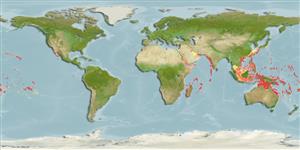Hexacorallia |
Scleractinia |
Faviidae
Environment: milieu / climate zone / εύρος βάθους / distribution range
Οικολογία
Υφαλόφιλο(α); εύρος βάθους 0 - 86 m (Αναφ. 107543). Tropical; 36°N - 34°S, 26°E - 108°W (Αναφ. 848)
Indo-Pacific: Japan to South Africa and Red Sea to Easter Island. Tropical and subtropical.
Length at first maturity / Μέγεθος / Weight / Age
Γεννητική Ωρίμανση: Lm ? range ? - ? cm
Has a distinctive dark brown coloration with a white oral disc.
Can be found in shallow waters (Ref. 122680). Expands during daytime. Surface is usually pock-marked with barnacles, tube worms, and holes made by Lithophaga sp. (Ref. 130769).
Life cycle and mating behavior
Γεννητική Ωρίμανση | Αναπαραγωγή | Γεννοβολία | Eggs | Γονιμότητα | Larvae
Members of the class Anthozoa are either gonochoric or hermaphroditic. Mature gametes are shed into the coelenteron and spawned through the mouth. Life cycle: The zygote develops into a planktonic planula larva. Metamorphosis begins with early morphogenesis of tentacles, septa and pharynx before larval settlement on the aboral end.
Ross, M.A. and G. Hodgson 1981 A quantitative study of hermatypic coral diversity and zonation at Apo Reef, Mindiro, Philippines. Proceedings of the Fourth International Coral Reef Syposium, Manila 2:281-291. (Αναφ. 8294)
IUCN Red List Status
(Αναφ. 130435: Version 2025-1)
CITES status (Αναφ. 108899)
Not Evaluated
Threat to humans
Human uses
| FishSource |
Εργαλεία
Περισσότερες πληροφορίες
Τροφική ΟικολογίαFood items (preys)
Σύσταση δίαιτας
Κατανάλωση τροφής
Θηρευτές
Population dynamicsΑύξησηMax. ages / sizesLength-weight rel.Length-length rel.Length-frequenciesMass conversionΑφθονία Life cycleΑναπαραγωγήΓεννητική ΩρίμανσηΓονιμότηταΓεννοβολίαEggsEgg developmentLarvae PhysiologyΚατανάλωση οξυγόνου
Human RelatedStamps, coins, misc.
Διαδικτυακές πηγές
Estimates based on models
Preferred temperature
(Ref.
115969): 24.3 - 28.8, mean 27.5 (based on 724 cells).
Price category
Unknown.
